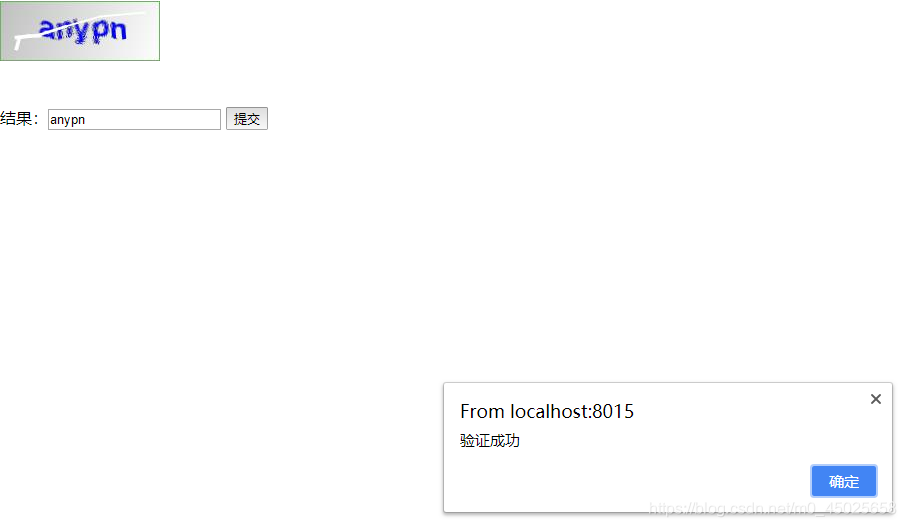spring boot 验证码(算术型和字符型)和生成
上次我们老师给我们一个任务:使用python生成验证码,但是我想用java来生成,于是就有了这一篇博客。
这个源码时我在github上找的(已经有一段时间了,我找不到作者的原原版了,只有我的经过修改后的注释版),我将带大家分享一下作者是如何来生成的验证码的。
下面是我的开发环境和使用技术
开发环境:IDEA
使用技术:spring boot,thymeleaf
1.先看看实际效果把
字符型的验证码
当输入正确时

当输入错误时

算术型验证码
当输入正确时

当输入错误时

如上图所示,支持算数型和字符型验证码。下面将一步一步解析作者的代码。
首先是使用到的jar包
<?xml version="1.0" encoding="UTF-8"?>
<project xmlns="http://maven.apache.org/POM/4.0.0" xmlns:xsi="http://www.w3.org/2001/XMLSchema-instance"
xsi:schemaLocation="http://maven.apache.org/POM/4.0.0 http://maven.apache.org/xsd/maven-4.0.0.xsd">
<modelVersion>4.0.0</modelVersion>
<parent>
<groupId>org.springframework.boot</groupId>
<artifactId>spring-boot-starter-parent</artifactId>
<version>2.1.4.RELEASE</version>
<relativePath/> <!-- lookup parent from repository -->
</parent>
<groupId>com.zr</groupId>
<artifactId>yanzhengma</artifactId>
<version>0.0.1-SNAPSHOT</version>
<name>yanzhengma</name>
<description>Demo project for Spring Boot</description>
<properties>
<java.version>1.8</java.version>
</properties>
<dependencies>
<dependency>
<groupId>org.springframework.boot</groupId>
<artifactId>spring-boot-starter-web</artifactId>
</dependency>
<dependency>
<groupId>org.springframework.boot</groupId>
<artifactId>spring-boot-starter-test</artifactId>
<scope>test</scope>
</dependency>
<!--验证码 -->
<dependency>
<groupId>com.github.penggle</groupId>
<artifactId>kaptcha</artifactId>
<version>2.3.2</version>
</dependency>
<!--热编译插件-->
<dependency>
<groupId>org.springframework.boot</groupId>
<artifactId>spring-boot-devtools</artifactId>
<optional>true</optional>
</dependency>
<!--thymeleaf模板-->
<dependency>
<groupId>org.springframework.boot</groupId>
<artifactId>spring-boot-starter-thymeleaf</artifactId>
</dependency>
</dependencies>
<build>
<plugins>
<plugin>
<groupId>org.springframework.boot</groupId>
<artifactId>spring-boot-maven-plugin</artifactId>
<configuration>
<fork>true</fork> <!-- 如果没有该配置,devtools不会生效 -->
</configuration>
</plugin>
</plugins>
</build>
</project>
要引入的jar中生成验证码的是kaptcha
下面就正式开始了
首先是部分前端代码(剩余的部分在解析部分时在说)
<img th:src="@{/captcha/captchaImage(type='math')}" class="imgcode">
你没看错,只有一条,这是thymeleaf的格式,用户点击该图片就会传到控制器。再通过控制器等等操作,来达到切换验证码的效果
部分控制器代码(剩余的部分在解析部分时在说)
@Controller
@RequestMapping("/captcha")
public class SysCaptchaController {
//字符
@Resource(name = "captchaProducer")
private Producer captchaProducer;
//数字
@Resource(name = "captchaProducerMath")
private Producer captchaProducerMath;
/**
* 验证码生成
*/
@GetMapping(value = "/captchaImage")
public ModelAndView getKaptchaImage(HttpServletRequest request, HttpServletResponse response) {
ServletOutputStream out = null;
try {
HttpSession session = request.getSession();
//设置响应类型为图片
response.setContentType("image/jpeg");
//获得前端发送来的type="math"或"char"
String type = request.getParameter("type");
//码
String capStr = null;
//值
String code = null;
BufferedImage bi = null;
//如果传来的type=math,生成算术型验证码
if ("math".equals(type)) {
//创建验证码中的内容
String capText = captchaProducerMath.createText();
//substring:截取字符串
//lastIndexOf:返回参数从字符串右边开始的索引
//capStr中是capText从0位到@位之前的数据
capStr = capText.substring(0, capText.lastIndexOf("@"));
//输出码
System.out.println(capStr);
//获得上面剩余的字符
//code中是@之后的数,一个随机数(就是验证码)
code = capText.substring(capText.lastIndexOf("@") + 1);
//输出值
System.out.println(code);
//创建验证码
bi = captchaProducerMath.createImage(capStr);
}
//如果类型为字符型
else if ("char".equals(type)) {
capStr = code = captchaProducer.createText();
bi = captchaProducer.createImage(capStr);
}
//向web端写出
session.setAttribute(Constants.KAPTCHA_SESSION_KEY, code);
out = response.getOutputStream();
ImageIO.write(bi, "jpg", out);
out.flush();
} catch (Exception e) {
e.printStackTrace();
} finally {
try {
if (out != null) {
out.close();
}
} catch (IOException e) {
e.printStackTrace();
}
}
return null;
}
我大概的说说吧,上面都有我写的注释。前端传来的“math"或"char"通过下面的代码来生成不同类型的验证码
if ("math".equals(type)) {
xxx
}
else if ("char".equals(type)) {
xxx、
}
下面的代码代表表示注入一个catchaProducer和captchaProducerMath的配置类,用来配置验证码的格式
//字符
@Resource(name = "captchaProducer")
private Producer captchaProducer;
//数字
@Resource(name = "captchaProducerMath")
private Producer captchaProducerMath;
就是注入下面的配置类
/**
* 验证码配置
*/
@Configuration
public class CaptchaConfig
{
//设置验证码的格式
@Bean(name = "captchaProducer")
public DefaultKaptcha getKaptchaBean()
{
DefaultKaptcha defaultKaptcha = new DefaultKaptcha();
Properties properties = new Properties();
// 是否有边框 默认为true 我们可以自己设置yes,no
properties.setProperty("kaptcha.border", "yes");
// 边框颜色 默认为Color.BLACK
properties.setProperty("kaptcha.border.color", "105,179,90");
// 验证码文本字符颜色 默认为Color.BLACK
properties.setProperty("kaptcha.textproducer.font.color", "blue");
// 验证码图片宽度 默认为200
properties.setProperty("kaptcha.image.width", "160");
// 验证码图片高度 默认为50
properties.setProperty("kaptcha.image.height", "60");
// 验证码文本字符大小 默认为40
properties.setProperty("kaptcha.textproducer.font.size", "30");
// KAPTCHA_SESSION_KEY
properties.setProperty("kaptcha.session.key", "kaptchaCode");
// 验证码文本字符间距 默认为2
properties.setProperty("kaptcha.textproducer.char.space", "3");
// 验证码文本字符长度 默认为5
properties.setProperty("kaptcha.textproducer.char.length", "5");
// 验证码文本字体样式 默认为new Font("Arial", 1, fontSize), new Font("Courier", 1, fontSize)
properties.setProperty("kaptcha.textproducer.font.names", "Arial,Courier");
// 验证码噪点颜色 默认为Color.BLACK
properties.setProperty("kaptcha.noise.color", "white");
Config config = new Config(properties);
defaultKaptcha.setConfig(config);
return defaultKaptcha;
}
//设置算术验证码格式
@Bean(name = "captchaProducerMath")
public DefaultKaptcha getKaptchaBeanMath()
{
DefaultKaptcha defaultKaptcha = new DefaultKaptcha();
Properties properties = new Properties();
// 是否有边框 默认为true 我们可以自己设置yes,no
properties.setProperty("kaptcha.border", "yes");
// 边框颜色 默认为Color.BLACK
properties.setProperty("kaptcha.border.color", "105,179,90");
// 验证码文本字符颜色 默认为Color.BLACK
properties.setProperty("kaptcha.textproducer.font.color", "blue");
// 验证码图片宽度 默认为200
properties.setProperty("kaptcha.image.width", "160");
// 验证码图片高度 默认为50
properties.setProperty("kaptcha.image.height", "60");
// 验证码文本字符大小 默认为40
properties.setProperty("kaptcha.textproducer.font.size", "35");
// KAPTCHA_SESSION_KEY
properties.setProperty("kaptcha.session.key", "kaptchaCodeMath");
// 验证码文本生成器
properties.setProperty("kaptcha.textproducer.impl", "com.zr.yanzhengma.config.KaptchaTextCreator");
// 验证码文本字符间距 默认为2
properties.setProperty("kaptcha.textproducer.char.space", "3");
// 验证码文本字符长度 默认为5
properties.setProperty("kaptcha.textproducer.char.length", "6");
// 验证码文本字体样式 默认为new Font("Arial", 1, fontSize), new Font("Courier", 1, fontSize)
properties.setProperty("kaptcha.textproducer.font.names", "Arial,Courier");
// 验证码噪点颜色 默认为Color.BLACK
properties.setProperty("kaptcha.noise.color", "white");
// 干扰实现类
properties.setProperty("kaptcha.noise.impl", "com.google.code.kaptcha.impl.NoNoise");
// 图片样式 水纹com.google.code.kaptcha.impl.WaterRipple 鱼眼com.google.code.kaptcha.impl.FishEyeGimpy 阴影com.google.code.kaptcha.impl.ShadowGimpy
properties.setProperty("kaptcha.obscurificator.impl", "com.google.code.kaptcha.impl.ShadowGimpy");
Config config = new Config(properties);
defaultKaptcha.setConfig(config);
return defaultKaptcha;
}
}
String capText = captchaProducerMath.createText();是创建算式验证码的内容,代码如下
package com.zr.yanzhengma.config;
/**
* 验证码文本生成器
*/
public class KaptchaTextCreator extends DefaultTextCreator
{
private static final String[] CNUMBERS = "0,1,2,3,4,5,6,7,8,9,10".split(",");
@Override
public String getText()
{
Integer result = 0;
Random random = new Random();
int x = random.nextInt(10);
int y = random.nextInt(10);
StringBuilder suChinese = new StringBuilder();
int randomoperands = (int) Math.round(Math.random() * 2);
if (randomoperands == 0)
{
result = x * y;
suChinese.append(CNUMBERS[x]);
suChinese.append("*");
suChinese.append(CNUMBERS[y]);
}
else if (randomoperands == 1)
{
if (!(x == 0) && y % x == 0)
{
result = y / x;
suChinese.append(CNUMBERS[y]);
suChinese.append("/");
suChinese.append(CNUMBERS[x]);
}
else
{
result = x + y;
suChinese.append(CNUMBERS[x]);
suChinese.append("+");
suChinese.append(CNUMBERS[y]);
}
}
else if (randomoperands == 2)
{
if (x >= y)
{
result = x - y;
suChinese.append(CNUMBERS[x]);
suChinese.append("-");
suChinese.append(CNUMBERS[y]);
}
else
{
result = y - x;
suChinese.append(CNUMBERS[y]);
suChinese.append("-");
suChinese.append(CNUMBERS[x]);
}
}
else
{
result = x + y;
suChinese.append(CNUMBERS[x]);
suChinese.append("+");
suChinese.append(CNUMBERS[y]);
}
suChinese.append("=?@" + result);
return suChinese.toString();
}
}
//向web端写出
session.setAttribute(Constants.KAPTCHA_SESSION_KEY, code);
out = response.getOutputStream();
ImageIO.write(bi, "jpg", out);
out.flush();
到在这里应该就没有什么问题了,验证码生成成功,返回前端用来显示。
下一篇讲解析生成的二维码,其实将这篇看懂了,解析就很简单了,比对一下就可以了,为了防止篇幅太大,就另写一篇吧。
如果有什么问题的话,留言就可以了。
源码在我的下载里面(还没有审核,要等一段时间)
